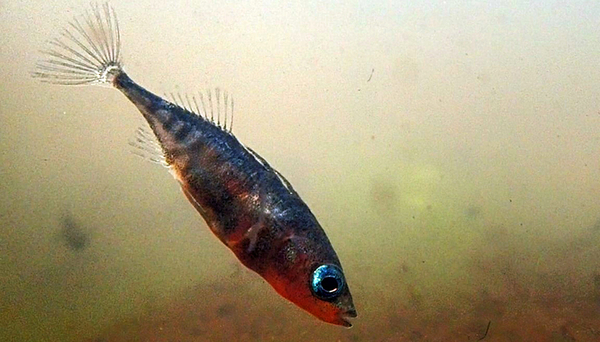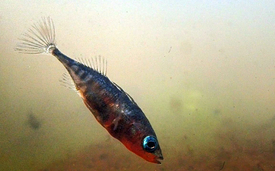News Detail
“Copying & pasting” a gene allows stickleback to live in freshwater habitats
June 3, 2019 |
Darwin himself recognised the principle of adaptive radiation as being an important process in evolution. This principle says that, in a competitive situation, individuals in a species will search for new niches, where their populations adapt to environmental conditions through natural selection. This means that a single original species can fan out and evolve into numerous species with different niches. Of course, nowhere near all species within one family manage to adapt to new surroundings. A classic example of this is seen in the case of the stickleback.
The three-spined stickleback lives mainly in marine waters. Over the course of time it also ventured into freshwater bodies and radiated out into various ecotypes. This is in contrast to its sister species, the Japanese sea stickleback, which never managed to colonise freshwater bodies.
Why some species are able to adapt to very different environmental conditions, while others are not, is a key question of evolutionary biology, which had remained unanswered in the case of the stickleback until very recently. Now a team of biologists from Eawag, the University of Bern and the National Institute of Genetics in Shizuoka, Japan, have discovered a clue in the genetic material of the fish, namely, a gene called “Fads2”. This gene converts unusable fatty acids into useful ones – primarily into the essential fatty acid, docosahexaenoic acid (DHA). This is particularly important in fresh water, as the food there contains practically no DHA, in contrast to that of marine environments. To avoid starvation in freshwater, fish therefore have to make these fatty acids themselves, using an enzyme that is coded by the gene Fads2.
A sea stickleback in a dune water of a Danish North Sea island: The sticklebacks make their nests there, but the young fish migrate back into the sea soon after hatching and come back for breeding. These fish have three (male) or four (female) copies of the Fads2 gene. This is enough to survive in fresh water.
(Photo: Ole Seehausen, Eawag)
Chance duplication
In laboratory experiments in which fry were raised on freshwater food, three-spined sea sticklebacks grew properly, whereas Japanese sea sticklebacks starved. With the help of genetic analysis, the researchers discovered that the Japanese sea stickleback and also the slightly more distant relative, the blackspotted stickleback, both had just one copy of the gene, whereas three-spined sticklebacks had more. When the researchers inserted additional copies of Fads2 into the genetic material of the Japanese sea stickleback, the offspring of these fish survived on freshwater food.
“What my Japanese colleague Asano Ishikawa made to happen in the laboratory, happened to the three-spined stickleback in nature only by pure coincidence”, says Ole Seehausen, a biologist at Eawag and the University of Bern. The gene was duplicated in the genome by chance a long time ago, which then allowed the three-spined stickleback to later colonise freshwater bodies.
As time went on and the fish adapted to life in freshwater lakes and rivers, even additional copies were made, and so the oldest freshwater populations of three-spined sticklebacks that were formed long before the last ice age have been found to possess significantly more Fads2 copies than the sea populations and the many younger freshwater populations that emerged after the last ice age.
Often disadvantageous
Genetic mutations are usually disadvantageous. According to the researchers it is very rarely the case, particularly with duplications, that they lead to something advantageous. For example, a gene can be copied incompletely or reintroduced into the wrong place. It is therefore not surprising that relatives of the three-spined stickleback such as the Japanese stickleback have only one copy of the Fads2 gene and therefore remained sea-bound.
The study was the result of a collaboration between three research departments: with scientists from Eawag and the University of Bern, and Japanese researchers at the National Institute of Genetics in Shizuoka under Dr Asano Ishikawa und Dr Jun Kitano.
Original publication
A key metabolic gene for recurrent freshwater colonization and radiation in fishes.


